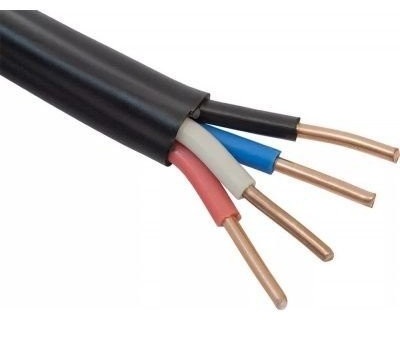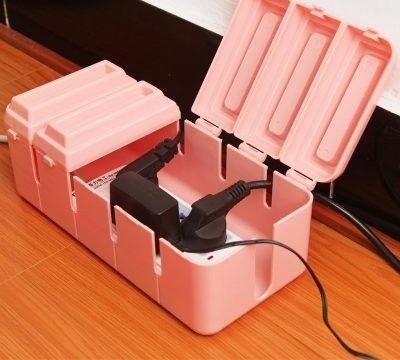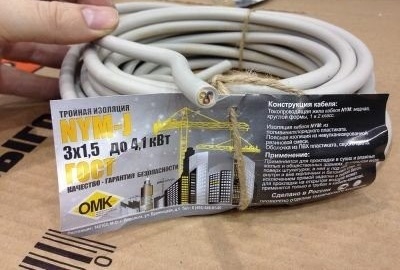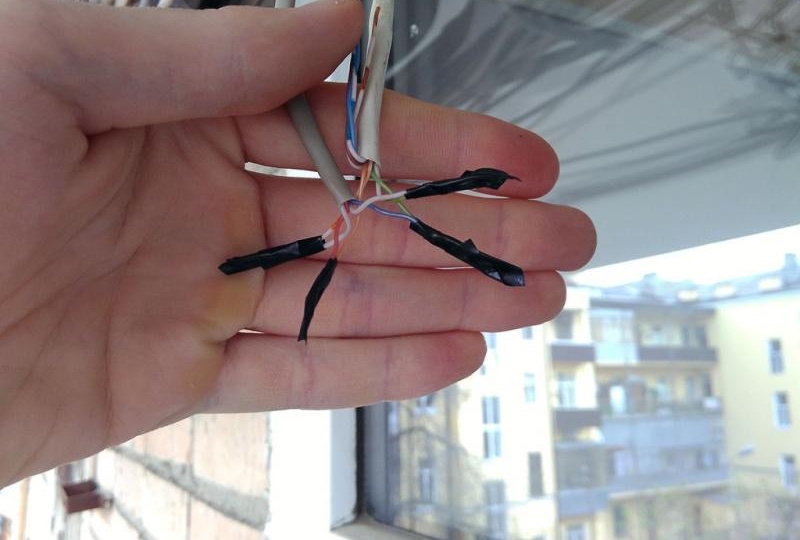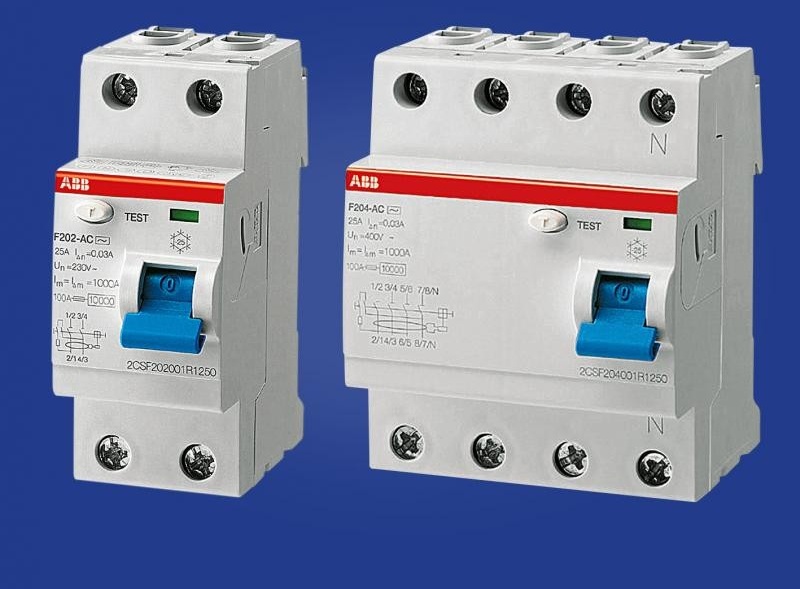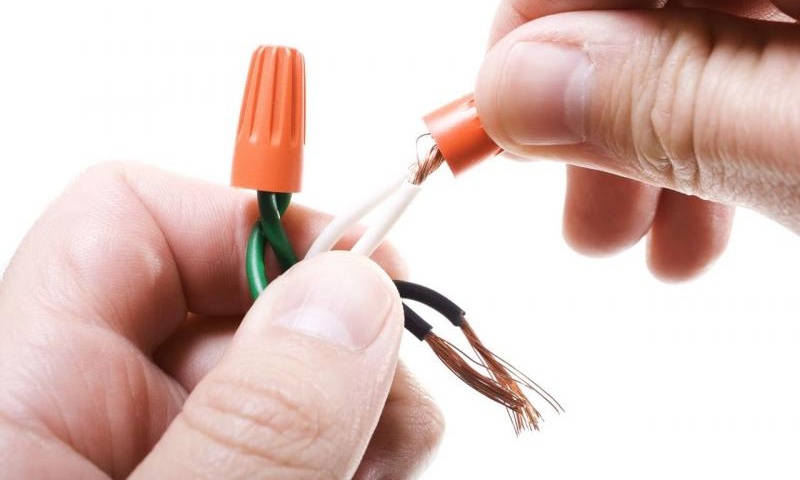How to choose wires for electrifying a house
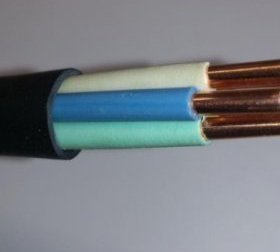
Each wire, cable or cord has a factory marking on the top layer of insulation. Using conditional abbreviations in letters and numbers in a certain order, the inscription encrypted the complete information about the material of the conductor, rated power, insulation properties of the braid. The scope of this type of product and its operational properties are also indicated there. Understanding the marking and knowing how to calculate the wires will allow you to easily select cables for the house, garage or cottage, as well as independently calculate the desired length and cross section.
Content
Wire marking
The standard of symbols is the same for all types of cable products and is subject to mandatory compliance with certification standards.
The purpose of the labeling is to inform the consumer about the basic properties of electrical products. In wires, these include:
- metal of which the conductor is made;
- functional purpose;
- conductor design;
- core cross-sectional area;
- rated voltage;
- type and material of the insulation coating.
In addition to the factory markings, which can be color, letter and digital, there is the so-called marking of cable endings, which is applied with a marker or using a glued tag.
This marking is carried out by the electrician during the wiring of wires and cables over the network.
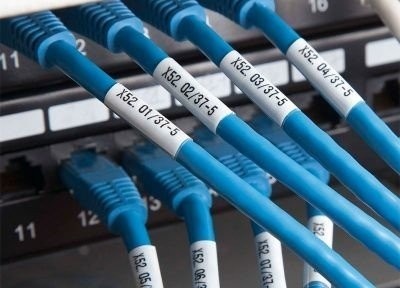
Cable terminations are marked so that you can quickly understand where this or that line is laid from
Another type of marking is considered an electronic marker - a device that allows you to find the location of power and telecommunication cables underground, inside sewers and other hard-to-reach places.
Color marking is regulated by GOST R50462-2009 (IEC 60446: 2007), which sets out the principles for identifying wires by alphabetic and digital abbreviations, as well as color painting.
Table: identification of conductors by color code and alphanumeric designation
| Conductor | Alphanumeric Identification | Color identification | |
| Colour | Color code according to GOST 28763 | ||
| AC electric circuit | |||
| Single Phase Phase Conductor | L | Brown | Bn |
| Three-phase phase conductor 1 | L1 | ||
| Three-phase phase conductor 2 | L2 | The black | VK |
| Three-phase phase conductor 3 | L3 | Gray | Gy |
| Grounded phase conductor single phase circuit | LE | Blue | BU |
| Grounded three-phase phase conductors | LE1, LE2, LE3 | ||
| Neutral conductor | N | ||
| DC circuit | |||
| Positive pole conductor | L + | Brown | Bn |
| Negative pole conductor | L- | Gray | Gy |
| Grounded positive pole conductor | LE + | Blue | BU |
| Grounded Negative Pole Conductor | LE- | ||
| Middle conductor | M | ||
| Protective conductors and conductors combining the functions of protective conductors | |||
| Protective conductor | RE | Green yellow | GNYE |
| PEL conductor | Pel | ||
| PEM conductor | PEM | ||
| PEN conductor | PEN | Blue | BU |
| Potential equalizing protective conductor | RB | Green yellow | GNYE |
Classification of conductive devices
To correctly understand the marking code, you need to know that all conductive devices are divided into three main groups:
- Wires.
- Cables.
- Cords.
Electric wires
A wire is a product in the form of a metal rod in isolation or without it. For electrical purposes, mainly wires made of copper or aluminum are used. There are also wires from other metals - nichrome, gold, silver, but they are mainly used in computer and space technology.
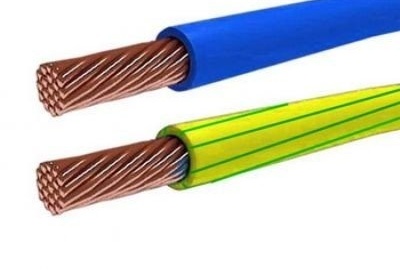
In most cases, copper wires are used for household wiring: they last longer and are able to withstand high currents than aluminum
Aluminum is used less and less, since its properties limit the load on the network. Most often, aluminum is used in power lines (power lines), as it is much lighter and cheaper than copper.
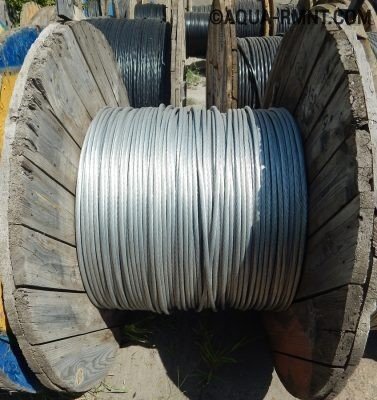
Aluminum wire is most often used for overhead power lines because it is lighter and cheaper than copper
By purpose, the wires are divided into three subspecies:
- Power.
- Installation.
- Mounting.
Power wires are used to transmit electric current to a distance, installation and assembly wires - for switching individual elements inside an electric circuit.
Electrical cable
A cable is a combination of several wires located inside one insulating sheath, which is made of polyvinyl chloride, plastic or rubber.
Cables, like wires, are also divided into types of application:
- Power. Serve for voltage transmission.
- Cables for communication. They are used as current conductors with various frequency characteristics. There are low-frequency and high-frequency.
- Control cables Special type of cable products equipped with a protective screen. It is used in automation systems for transmitting commands.
- Control. Used to transmit an information signal in electrical devices.
- Radio frequency. Transmit radio and video signals.
Electrical cords
A cord is a power cable made of two or three flexible cores, the purpose of which is to transfer current from a power source to an electrical appliance. Mainly used to connect household and industrial equipment.
Video: how wires and cables differ
Explanation of the marking of electrical conductors
For an example of decoding, consider the first 4 letters and 3 digits of the marking. They reflect the most important information for consumers.
- The first letter indicates what the conductor core is made of. If it is copper - the letter is not put, if aluminum - the letter "A" will be the first.
- The second letter describes the insulation material or type of wire. For example, “M” is installation, “U” is installation, “K” is control, “P” is flat, “B” is a sheath made of PVC, “ШВ” is made from a extruded PVC hose, etc.
- The third letter characterizes the insulating material covering the metal core. “B” means polyvinyl chloride, “P” means rubber, “P” means polyethylene, etc.
- The fourth letter describes the design features of the conductor. For example, “K” is armored, “T” is special for pipes, “O” is a braided cable.
The numbers following the letters on the wire carry the information in the following order.
- The first figure reflects the structure of the cable - how many cores are in its composition. The absence of numbers indicates the monolithicity of the conductor.
- The second digit indicates the cross-sectional area of the core, expressed in square millimeters. Usually it is separated from the first by an “x”.
- The third digit indicates the magnitude of the calculated voltage. (For example: 220 V, 380 V, etc.).
In addition, between the sequences of letters and numbers there may be additional abbreviations indicating design features of a particular cable, for example:
- "Ng" - does not support combustion;
- "HP" - a shell made of non-combustible rubber;
- "LS" - reduced smoke emission.
For example, consider the decoding of the marking of a popular cable for performing internal wiring in private houses and apartments - VVGng 3x2.5. According to the above rules, you can understand that this is a cable:
- with copper conductors (the letter “A” is absent at the beginning, which means not aluminum);
- with a sheath and insulation of cores made of polyvinyl chloride (second and third letters "B");
- without a protective layer over the shell ("G");
- not supporting combustion ("ng");
- consisting of three conductors with a cross section of 2.5 mm2 each one.
Labeling methods for cable marking are not limited. There are many different options, therefore, for convenience, all abbreviations are summarized in special tables.
Table: labeling of power cables with PVC and rubber insulation
| Marking | Designation |
| AC | aluminum core and steel sheath |
| AA | aluminum core and aluminum sheath |
| B | armor from two steel tapes with a corrosion-resistant coating |
| In (first) | PVC insulation |
| B (second) | PVC sheath |
| G | without protective layer over the shell |
| Seam | extruded PVC hose sheath |
| Shp | extruded polyethylene hose sheath |
| TO | galvanized steel wire armor |
| WITH | lead sheath |
| ABOUT | separate shells on top of each phase |
| R | rubber insulation |
| HP | flame retardant rubber sheath |
| Ps | self-extinguishing polyethylene insulation or sheath |
| Pv | vulcanized polyethylene insulation |
| ng | does not support combustion |
| LS | low smoke |
| KG | flexible cable |
Imported conductors have some excellent marking.
Table: Labeling of imported cross-linked polyethylene insulation cables
| Marking | Designation |
| N | made according to German VDE standard |
| Y | PVC insulation |
| 2Y | polyethylene insulation |
| 2X | XLPE insulation |
| S | copper screen |
| (F) | longitudinal sealing |
| (Fl) | longitudinal and transverse sealing |
| E | three core cable |
| J | the presence of a yellow-green core |
| M | installation in various conditions is allowed |
| R | round steel wire armor |
Wire selection criteria
A wire, cable or cord is selected according to several basic criteria.
Material conductor selection
Currently, copper is most widely used; aluminum has begun to fade into the background. This is due to the fact that the conductivity characteristics of a copper core are much higher than that of aluminum. The service life of aluminum is limited to 25 years, while copper can last over 50 years. Lightweight and cheap aluminum is used for high voltage power lines. Copper conductor - for engines, power cables inside buildings, installation works. The use of aluminum conductors inside apartments and houses is prohibited.
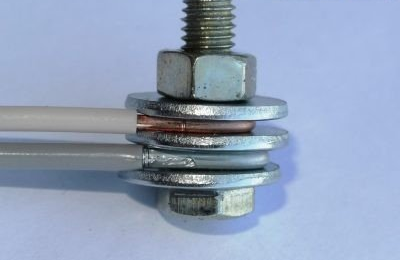
Although the use of aluminum cables in residential premises is prohibited, they are still often found in old apartments, so you need to remember: you can connect copper and aluminum conductors only through a third metal (for example, steel)
Flexible cables and wires
The flexibility of the wire is needed when its operation is associated with frequent bends. For example, the cords of household appliances or power tools are constantly reeled up for easy storage and transportation. If such a cord does not have elasticity, then it will quickly break and cease to fulfill its function. In order to prevent this from happening, cables of a special design are produced, consisting of many small, filamentous strands woven together. As a rule, they are varnished, with a cotton braid and packaged in rubber insulation. Such cords easily withstand multiple deformations without damage to their destination. In addition, during installation work on lengthening and extension of cables, flexible conductors are also used.
Conductor cross section
The conductor cross-sectional area is one of the most important characteristics for the correct selection of cable. If the cross section does not correspond to the power consumption, then the wire begins to heat up, its electrical resistance increases. This can lead not only to a significant cost overrun of electricity, but also to an unsafe fire hazard situation, short circuit. If the cross section is larger than necessary, nothing terrible will happen, but such wiring will cost unreasonably expensive. Therefore, in order to determine the optimal cable thickness, it is better to use simple formulas. Here is one of them: Ptotal= (P1+ P2+ P3... + PN) ∙ 0.8. Here p1, R2 etc. - power consumption of electrical appliances. The total value is multiplied by a factor of 0.8, since in real life all devices never turn on simultaneously and for a long time. Next, the desired value of the cross-sectional area of the conductor is in the table. It is also necessary to take into account the limitations of the path length, since the cable has its own resistance, which is the reason for the loss of power due to heating.
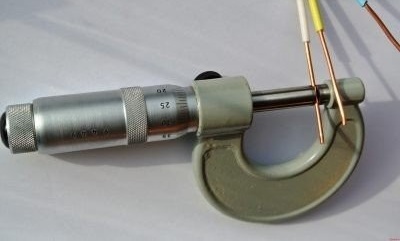
If the cable is not marked, its diameter can be measured independently using a micrometer or vernier caliper, and to determine the radius, the obtained value must be divided in half
Table: cross-sectional area and maximum cable length depending on power consumption
| Cable section, mm2 and its maximum possible length, m | ||||||
| power, kWt | Current, A | 1,5 | 2,5 | 4 | 6 | 10 |
| 0,5 | 2,3 | 100 | 165 | 265 | 395 | — |
| 1 | 4,6 | 50 | 84 | 135 | 200 | 335 |
| 1,5 | 6,8 | 33 | 57 | 90 | 130 | 225 |
| 2 | 9 | 25 | 43 | 68 | 100 | 170 |
| 2,5 | 11,5 | 20 | 34 | 54 | 80 | 135 |
| 3 | 13,5 | 17 | 29 | 45 | 66 | 110 |
| 3,5 | 16 | 14 | 24 | 39 | 56 | 96 |
| 4 | 18 | — | 21 | 34 | 49 | 84 |
| 4,5 | 20 | — | 19 | 30 | 44 | 75 |
| 5 | 23 | — | — | 27 | 39 | 68 |
| 6 | 27 | — | — | 23 | 32 | 56 |
| 7 | 32 | — | — | — | 28 | 48 |
| 8 | 36 | — | — | — | — | 42 |
| 9 | 41 | — | — | — | — | 38 |
| 10 | 45 | — | — | — | — | 34 |
If the cable cross-sectional area is unknown, it can be calculated by measuring the diameter of the core. The area of the circle in this case will be equal to the square of the radius times 3.14.
Video: how to measure the cross section of an electric wire
Selection of wires according to the thickness of the core insulation
The thickness of the core insulation plays a large role in ensuring the safety of the use of electric current. The duration of cable operation depends on how reliably it protects the conductors from mechanical and other damages.In places of increased danger of moisture, wires are used in double insulation. In underground mines, for example, all cables are armored (covered with steel plates), since there is a great possibility of collapses and damage to wires. In underwater practice, special waterproof cables are used. In each case, the type of insulation that matches the operating conditions of the conductor is selected.
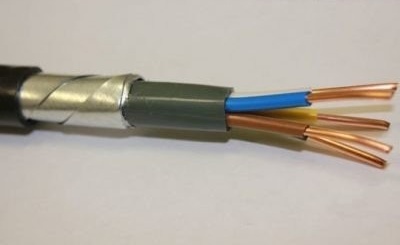
This cable has armor from two steel tapes with a corrosion-resistant coating (the letter “B” is in the marking)
Selection of cable cross-section by current
Calculation of the current consumption is also based on the specific devices that are supposed to be connected. You can determine the power of each unit of household appliances used, and then apply the formula I = P / U ∙ cosF, where I is the current strength, P is the power, cosF is the power factor (for household appliances included in a single-phase network, it can be approximately taken equal to unit). Thus, they find the current strength for each device individually. Then everything is summarized and the required wire cross section is selected according to the table.
Table: selection of the cross section of the copper cable by current
| Open wiring | Section mm2 |
Pipe gasket | ||||
| Current, A | power, kWt | Current, A | power, kWt | |||
| 220 V | 380 V | 220 V | 380 V | |||
| 11 | 2,4 | — | 0,5 | — | — | — |
| 15 | 3,3 | — | 0,75 | — | — | — |
| 17 | 3,7 | 6,4 | 1 | 14 | 3,0 | 5,3 |
| 23 | 5,0 | 8,7 | 1,5 | 15 | 3,3 | 5,7 |
| 26 | 5,7 | 9,8 | 2 | 19 | 4,1 | 7,2 |
| 30 | 6,6 | 11 | 2,5 | 21 | 4,6 | 7,9 |
| 41 | 9,0 | 15 | 4 | 27 | 5,9 | 10 |
| 50 | 11 | 19 | 6 | 34 | 7,4 | 12 |
| 80 | 17 | 30 | 10 | 50 | 11 | 19 |
Imported and domestic manufacturers: who should be preferred
There are many manufacturers of cable products. Conventionally, they can be divided into two groups: domestic and imported. Despite the existence of uniform standards, some cables differ in their properties with the same labeling. Nevertheless, domestic cables are deservedly considered competitive in the electrical market.
Video: how to choose a wire cross section
How to calculate losses and wire length
The calculation of losses along the length of the conductor is one of the practical ways to correctly determine its cross-sectional area. The basis of this method is the well-known fact that the resistance of a wire increases with an increase in its length. If, according to calculations on a certain section of the circuit, the energy loss is more than 5%, the conductor should be replaced with a thicker one. The calculations are carried out in the following order.
- The summation method determines the total power of electrical consumers.
- The wiring resistance is calculated by the formula R = (P ∙ L) / S, where R is the resistance, P is the total power of consumers, L is the length of the wire, S is the cross-sectional area. When calculating, you need to take into account that the current passes through the cable twice - first along one core, then along the other. Therefore, L should be equal to twice the actual cable length.
- The resulting resistance value is multiplied by the current strength and the magnitude of the voltage loss is obtained.
- Comparing this value in proportion to the nominal value of the voltage in the network, calculate the percentage of losses. If it turns out to be more than 5%, the conductor is considered not thick enough, it must be replaced.
Video: voltage losses in electric networks 220/380 V and 12 Volts
Unwanted wires for wiring (ШВВП, ПВС, ПУНП)
Despite the resemblance, all conductors should only be used for their intended purpose. The regulatory requirements of the PUE (Electrical Installation Rules) emphasize that all conductive products can be used only in those areas of production that are described in their technical passport. The passport is compiled on the basis of standards and technical conditions for cable operation.
This means, for example, that if in the house the wiring is mounted by conductors that do not meet the standards, in the event of a fire, no insurance company will pay insurance.
For example, wires of the PVS and ShVVP brands are very convenient to install, it is soft and supple. However, we read:
The PVA wire ... is designed to connect electrical appliances and power tools for housing care and repair, washing machines, refrigerators, small-scale mechanization tools for gardening and gardening and other similar machines and devices and for the manufacture of extension cords.
ShVVP brand wires are intended for connecting electronic equipment, microclimate devices, electric soldering irons, kitchen electromechanical devices, lamps, washing machines, refrigerators and other similar electrical devices used in everyday life, as well as ShVVP wire used to make extension cords.
The purpose of the VVG, VVGNG, VVGNG-ls cable is to distribute and transfer electric energy in stationary installations, for fixed installation of power circuits, control circuits and local lighting for a rated alternating voltage of up to 1 kV of a frequency of 50 Hz. These cables are most widely used in the installation of electrical wiring of residential and industrial facilities.

ShVVP wire belongs to the class of connecting, it is forbidden to do electrical wiring - for this there are VVG series cables
Neglecting these paragraphs of the Rules is not recommended, this can lead to irreversible tragic consequences.
Thus, when purchasing a cable for electrification of a house, a summer residence or a garage, you should pay attention not only to the price, material and cross-sectional area of the conductor, but also to its purpose, which is prescribed in the technical passport.
When installing and repairing self-wiring in a house or apartment, do not neglect the rules for installing cables in accordance with the marking characteristics. When buying, you need to carefully study the contents of the technical data sheet of the conductor and use the cable only for its intended purpose.

